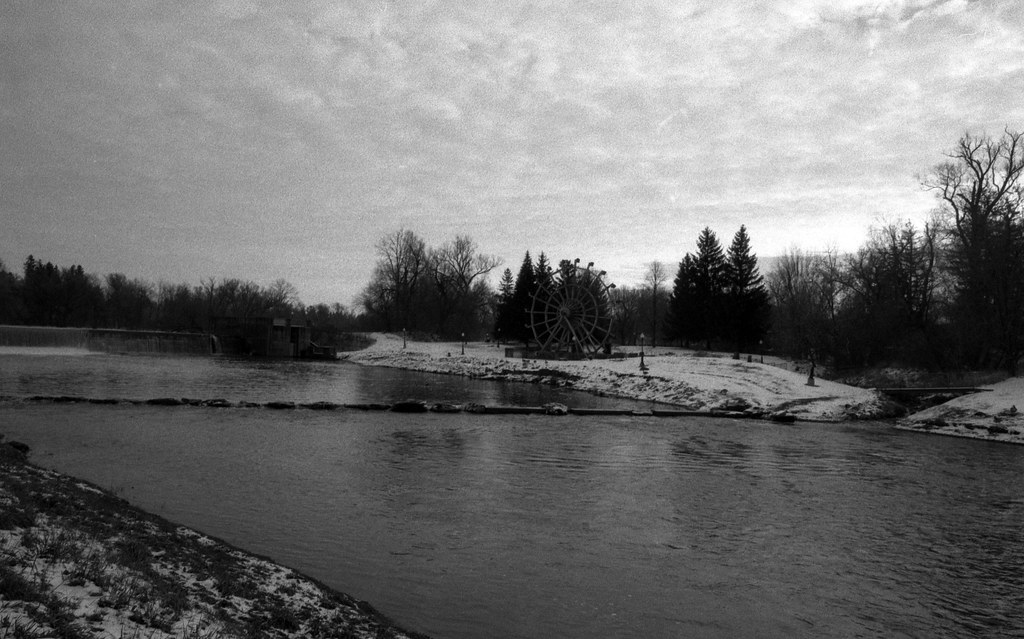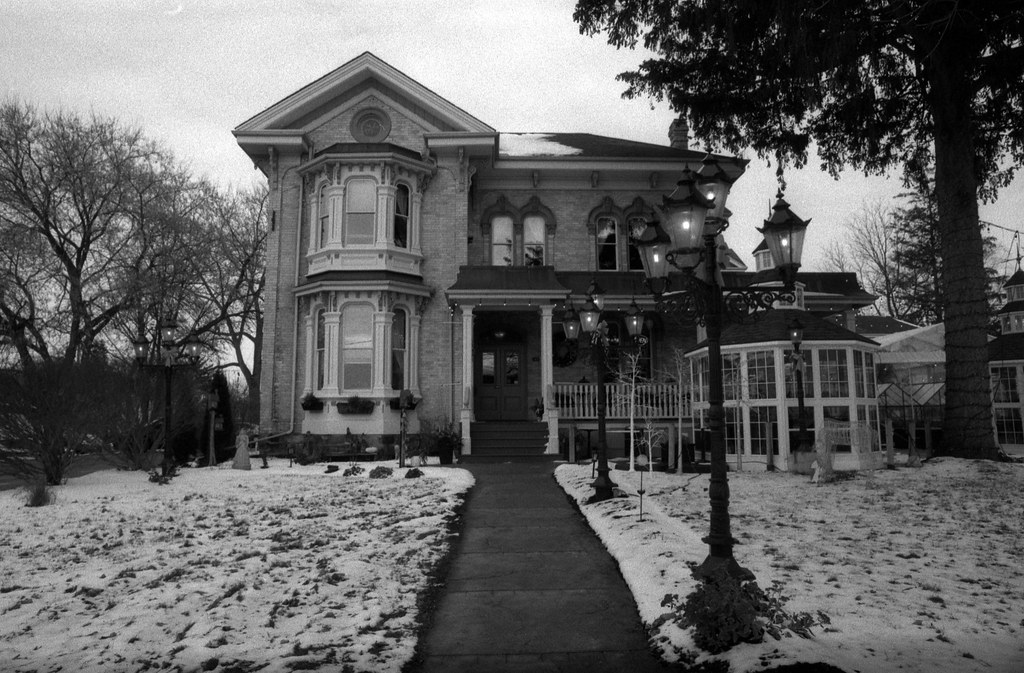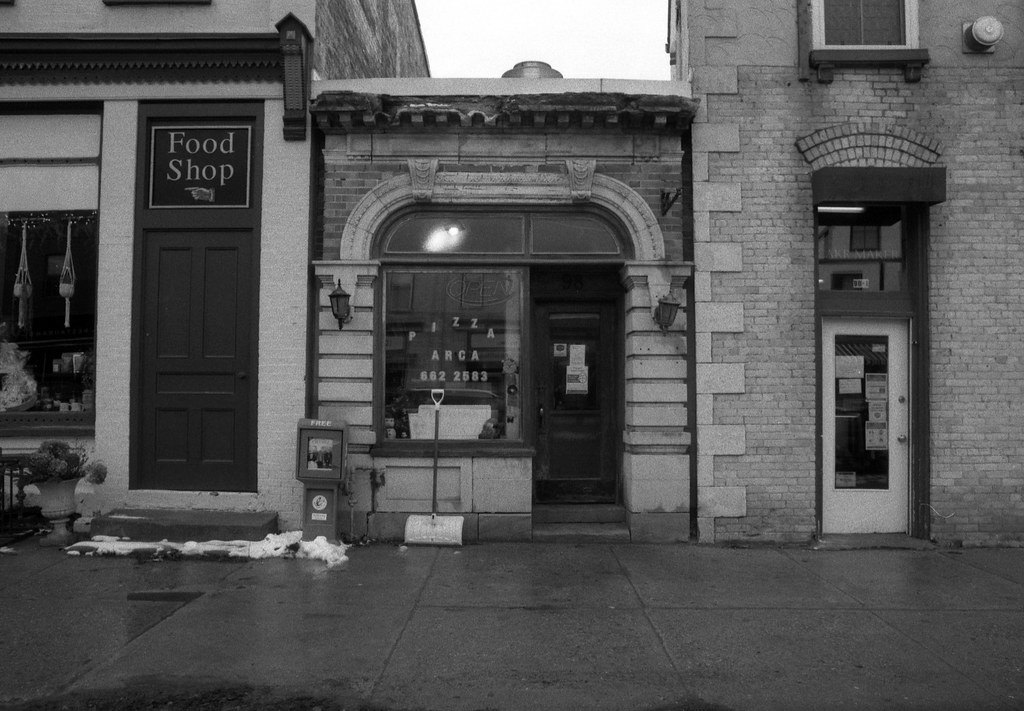There’s a good chance that if I’m heading along Highway 7/8, a sign for New Hamburg is something that I will generally ignore. If I’m in that part of Ontario, I’m on my way to points further west, good chance, Stratford. But I’m also a sucker for a new town, so I made the point to head into New Hamburg during a day out shooting for reviews last year. Like other communities in Southern Ontario, the town has been expanded outwards in urban sprawl with several new subdivisions. Still, it has also maintained a cosy historic downtown, which is where we’re exploring today.

Nikon FM – AI Nikkor 24mm 1:2.8 (Yellow-12) – Fomapan 40 @ ASA-200 – Ilford Ilfotec HC (1+63) 11:45 @ 20C
There is fertile soil and running water you will find a human settlement. While the original name for the land and the river remains lost in time. The area where New Hamburg stands today has passed through several different hands; the first was the Neutrals, the Attiwonderonk. They were pushed out and destroyed by the Haudenosaunee, and over time, they were pushed out by the Anishinabewaki or Mississaugas. After the formation of Upper Canada, British Colonial Authorities secured title to the land under Treaty 3 of 1792, designating the rich area as Crown Reserve. Essentially land in the ownership of the Monarchy is to be given as a reward for services rendered. Although some former slaves escaped and settled here, it remained uninhabited primarily and unsettled, carving a life out of the dense bush. The Post-War period brought a great deal of colonial expansion, including the sale of Crown Land to development companies, the largest being the Canada Company. Surveys in 1824 divided the land into townships, with Wilmot being accessed through the newly created Huron Road in 1828. The area’s rich soil and agriculture attracted many German immigrants, primarily those who followed the Amish and Mennonite beliefs. The first signs of a town came in 1832 when Josiah Cushman established a sawmill on Smith Creek, soon others joined, and additional mills took advantage of the water power afforded by the creek, the name Cassel became attached to the settlement and then Hamburg. The small settlement nearly vanished after a Cholera epidemic ripped through the area in 1834; despite everything, the colony survived. Although among the dead was Cushman, in 1838, the Cushman interests were purchased by a Scottish Lord, William Scott or Lord Campfield, who continued to expand the small community. Scott immediately put his mark, renaming Scott Creek the Nith River, building a new dam and establishing several new mills. The name of New Hamburg came in 1840 with the opening of the first post office; soon, more businesses arrived in the growing settlement. Although it was the arrival of the Grand Trunk Railway in 1856, things started to expand, and incorporation as a village came a year later. The industrial base only increased through the 1860s. More mills and factories opened along the Nith River, supported by other hotels, foundries, carriage works, taverns, three churches, and even a school. Agriculture remained the primary industry outside of New Hamburg, and the village continued to support that base in the rural sections. Scott’s sawmill continued to operate until 1902 when a fire destroyed the original structure, and it was replaced by flour and later feed mill in 1905 and still stands today. The New Hamburg Felt Boot Co also dates to 1898 and still operates, although the building is far older. While the village thrived through the early 20th century and even achieved incorporation as a town in 1966. The boom would not last long; de-industrialisation and the closure of many family farms proved too much. In changes, government structure resulted in dis-incorporation in 1973 and absorbed into Wilmot Township with several other rural villages. Thankfully the strong heritage movement in the community resulted in the designation of the central core as a Heritage District in 1992. Today New Hamburg is a small sleepy rural community with the historic centre maintained with an increasing urban sprawl on the periphery.

Nikon FM – AI Nikkor 24mm 1:2.8 (Yellow-12) – Fomapan 40 @ ASA-200 – Ilford Ilfotec HC (1+63) 11:45 @ 20C
Nikon FM – AI Nikkor 24mm 1:2.8 (Yellow-12) – Fomapan 40 @ ASA-200 – Ilford Ilfotec HC (1+63) 11:45 @ 20C
This week proved challenging to choose which images to include in the post as there are so many buildings in New Hamburg with excellent stories attached to them. So I went with a bit of help and found an only walking tour of the New Hamburg Heritage district and began to look at items that followed my own written history of the community and then found matching photos. The William Scott House and Puddicombe house. Some of the more interesting buildings, like the Standard Reliance & Mortgage Co building, are easy to miss because it’s tiny yet has a grand architecture usually reserved for large installations. The Imperial Hotel, while not the most imposing commercial block is where I got lunch the day I was visiting New Hamburg; they do an excellent Mac & Cheese. And while I would have liked to include more, the town’s short history meant that adding in a couple of bonus images may have thrown off the flow of the text block.

Nikon FM – AI Nikkor 24mm 1:2.8 (Yellow-12) – Fomapan 40 @ ASA-200 – Ilford Ilfotec HC (1+63) 11:45 @ 20C
Nikon FM – AI Nikkor 24mm 1:2.8 (Yellow-12) – Fomapan 40 @ ASA-200 – Ilford Ilfotec HC (1+63) 11:45 @ 20C
Through this project, I have learned that knowledge of a place is key to selecting the kit for photographing the location. In this case, knowing that the downtown is compact and has narrow streets, I went with the Nikkor 24mm f/2.8 and added a pale yellow filter to the lens. I could have gotten away with the 28mm lens, but the 24mm suited the space better. The addition of the 105mm probably wouldn’t have gone amiss, but I was also working with limited bag space on the trip. And working with bright light, I went with a one-stop over-exposure, shooting the film at ASA-200 and then pulling in development. For development, I went back to an old favourite, Ilford Ilfotec HC, running with a 1+63 dilution to help with compensating the over-exposure.

Nikon FM – AI Nikkor 24mm 1:2.8 (Yellow-12) – Fomapan 40 @ ASA-200 – Ilford Ilfotec HC (1+63) 11:45 @ 20C
Nikon FM – AI Nikkor 24mm 1:2.8 (Yellow-12) – Fomapan 40 @ ASA-200 – Ilford Ilfotec HC (1+63) 11:45 @ 20C
Next week I’m finally going to visit all the major parks under Conservation Halton with a visit to Rattlesnake Point!